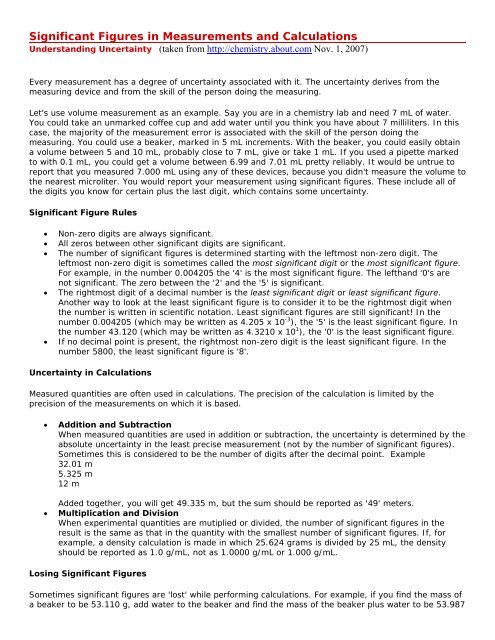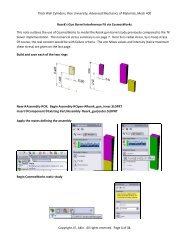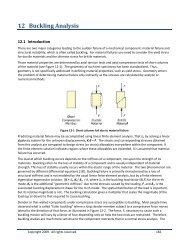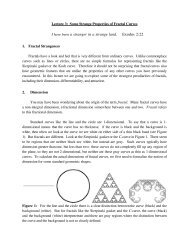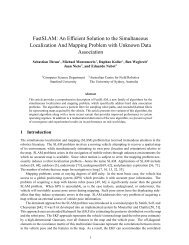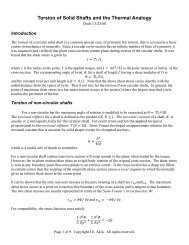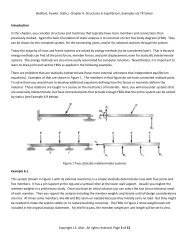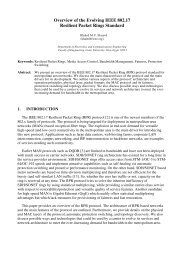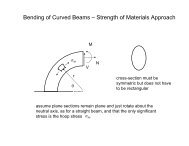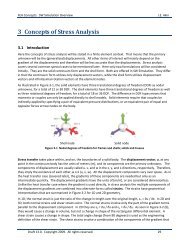Significant Figures in Measurements and Calculations - clear
Significant Figures in Measurements and Calculations - clear
Significant Figures in Measurements and Calculations - clear
You also want an ePaper? Increase the reach of your titles
YUMPU automatically turns print PDFs into web optimized ePapers that Google loves.
<strong>Significant</strong> <strong>Figures</strong> <strong>in</strong> <strong>Measurements</strong> <strong>and</strong> <strong>Calculations</strong>Underst<strong>and</strong><strong>in</strong>g Uncerta<strong>in</strong>ty (taken from http://chemistry.about.com Nov. 1, 2007)Every measurement has a degree of uncerta<strong>in</strong>ty associated with it. The uncerta<strong>in</strong>ty derives from themeasur<strong>in</strong>g device <strong>and</strong> from the skill of the person do<strong>in</strong>g the measur<strong>in</strong>g.Let's use volume measurement as an example. Say you are <strong>in</strong> a chemistry lab <strong>and</strong> need 7 mL of water.You could take an unmarked coffee cup <strong>and</strong> add water until you th<strong>in</strong>k you have about 7 milliliters. In thiscase, the majority of the measurement error is associated with the skill of the person do<strong>in</strong>g themeasur<strong>in</strong>g. You could use a beaker, marked <strong>in</strong> 5 mL <strong>in</strong>crements. With the beaker, you could easily obta<strong>in</strong>a volume between 5 <strong>and</strong> 10 mL, probably close to 7 mL, give or take 1 mL. If you used a pipette markedto with 0.1 mL, you could get a volume between 6.99 <strong>and</strong> 7.01 mL pretty reliably. It would be untrue toreport that you measured 7.000 mL us<strong>in</strong>g any of these devices, because you didn't measure the volume tothe nearest microliter. You would report your measurement us<strong>in</strong>g significant figures. These <strong>in</strong>clude all ofthe digits you know for certa<strong>in</strong> plus the last digit, which conta<strong>in</strong>s some uncerta<strong>in</strong>ty.<strong>Significant</strong> Figure Rules• Non-zero digits are always significant.• All zeros between other significant digits are significant.• The number of significant figures is determ<strong>in</strong>ed start<strong>in</strong>g with the leftmost non-zero digit. Theleftmost non-zero digit is sometimes called the most significant digit or the most significant figure.For example, <strong>in</strong> the number 0.004205 the '4' is the most significant figure. The lefth<strong>and</strong> '0's arenot significant. The zero between the '2' <strong>and</strong> the '5' is significant.• The rightmost digit of a decimal number is the least significant digit or least significant figure.Another way to look at the least significant figure is to consider it to be the rightmost digit whenthe number is written <strong>in</strong> scientific notation. Least significant figures are still significant! In thenumber 0.004205 (which may be written as 4.205 x 10 -3 ), the '5' is the least significant figure. Inthe number 43.120 (which may be written as 4.3210 x 10 1 ), the '0' is the least significant figure.• If no decimal po<strong>in</strong>t is present, the rightmost non-zero digit is the least significant figure. In thenumber 5800, the least significant figure is '8'.Uncerta<strong>in</strong>ty <strong>in</strong> <strong>Calculations</strong>Measured quantities are often used <strong>in</strong> calculations. The precision of the calculation is limited by theprecision of the measurements on which it is based.• Addition <strong>and</strong> SubtractionWhen measured quantities are used <strong>in</strong> addition or subtraction, the uncerta<strong>in</strong>ty is determ<strong>in</strong>ed by theabsolute uncerta<strong>in</strong>ty <strong>in</strong> the least precise measurement (not by the number of significant figures).Sometimes this is considered to be the number of digits after the decimal po<strong>in</strong>t. Example32.01 m5.325 m12 mAdded together, you will get 49.335 m, but the sum should be reported as '49' meters.• Multiplication <strong>and</strong> DivisionWhen experimental quantities are mutiplied or divided, the number of significant figures <strong>in</strong> theresult is the same as that <strong>in</strong> the quantity with the smallest number of significant figures. If, forexample, a density calculation is made <strong>in</strong> which 25.624 grams is divided by 25 mL, the densityshould be reported as 1.0 g/mL, not as 1.0000 g/mL or 1.000 g/mL.Los<strong>in</strong>g <strong>Significant</strong> <strong>Figures</strong>Sometimes significant figures are 'lost' while perform<strong>in</strong>g calculations. For example, if you f<strong>in</strong>d the mass ofa beaker to be 53.110 g, add water to the beaker <strong>and</strong> f<strong>in</strong>d the mass of the beaker plus water to be 53.987
g, the mass of the water is 53.987-53.110 g = 0.877 gThe f<strong>in</strong>al value only has three significant figures, even though each mass measurement conta<strong>in</strong>ed 5significant figures.Round<strong>in</strong>g <strong>and</strong> Truncat<strong>in</strong>g NumbersThere are different methods which may be used to round numbers. The usual method is to round numberswith digits less than '5' down <strong>and</strong> numbers with digits greater than '5' up (some people round exactly '5'up <strong>and</strong> some round it down).Example:If you are subtract<strong>in</strong>g 7.799 g - 6.25 g your calculation would yield 1.549 g. This number would berounded to 1.55 g, because the digit '9' is greater than '5'.In some <strong>in</strong>stances numbers are truncated, or cut short, rather than rounded to obta<strong>in</strong> appropriatesignificant figures. In the example above, 1.549 g could have been truncated to 1.54 g.Exact NumbersSometimes numbers used <strong>in</strong> a calculation are exact rather than approximate. This is true when us<strong>in</strong>gdef<strong>in</strong>ed quantities, <strong>in</strong>clud<strong>in</strong>g many conversion factors, <strong>and</strong> when us<strong>in</strong>g pure numbers. Pure or def<strong>in</strong>ednumbers do not affect the accuracy of a calculation. You may th<strong>in</strong>k of them as hav<strong>in</strong>g an <strong>in</strong>f<strong>in</strong>ite numberof significant figures. Pure numbers are easy to spot, because they have no units. Def<strong>in</strong>ed values orconversion factors, like measured values, may have units. Practice identify<strong>in</strong>g them!Example:You want to calculate the average height of three plants <strong>and</strong> measure the follow<strong>in</strong>g heights: 30.1 cm, 25.2cm, 31.3 cm; with an average height of (30.1 + 25.2 + 31.3)/3 = 86.6/3 = 28.87 = 28.9 cm. There arethree significant figures <strong>in</strong> the heights; even though you are divid<strong>in</strong>g the sum by a s<strong>in</strong>gle digit, the threesignificant figures should be reta<strong>in</strong>ed <strong>in</strong> the calculation.Accuracy <strong>and</strong> PrecisionAccuracy <strong>and</strong> precision are two separate concepts. The classic illustration dist<strong>in</strong>guish<strong>in</strong>g the two is toconsider a target or bullseye (we'll use arrows <strong>in</strong> this example). Arrows surround<strong>in</strong>g the bullseye <strong>in</strong>dicatea high degree of accuracy; arrows very near to each other (possibly nowhere near the bullseye) <strong>in</strong>dicate ahigh degree of precision. To be accurate an arrow must be near the target; to be precise successivearrows must be near each other. Consistently hitt<strong>in</strong>g the very center of the bullseye <strong>in</strong>dicates bothaccuracy <strong>and</strong> precision.Consider a digital scale. If you weigh the same empty beaker over <strong>and</strong> over <strong>and</strong> over aga<strong>in</strong> the scale willyield values with a high degree of precision (say 135.776 g, 135.775 g, 135.776 g). The actual mass ofthe beaker may be very different. Scales (<strong>and</strong> other <strong>in</strong>struments) need to be calibrated! Instrumentstypically provide very precise read<strong>in</strong>gs, but accuracy requires calibration. Thermometers are notoriously<strong>in</strong>accurate, often requir<strong>in</strong>g re-calibration several times over the lifetime of the <strong>in</strong>strument. Scales alsorequire recalibration, especially if they are moved or mistreated.Do you need more <strong>in</strong>formation <strong>and</strong> examples about significant figures? There are several resourcesavailable on the <strong>in</strong>ternet.Additional Read<strong>in</strong>g• <strong>Significant</strong> Figure Tutorial - Do you th<strong>in</strong>k you have a h<strong>and</strong>le on significant figures? This site offers aquick self-test.• <strong>Significant</strong> <strong>Figures</strong> - This site offers a comprehensive discussion of significant figures. There areseparate sections for def<strong>in</strong><strong>in</strong>g significant figures, tell<strong>in</strong>g which numbers are significant, deal<strong>in</strong>g with
zeros, underst<strong>and</strong><strong>in</strong>g scientific notation, mak<strong>in</strong>g calculations, review<strong>in</strong>g concepts, mak<strong>in</strong>gmeasurements, <strong>in</strong>troduc<strong>in</strong>g additional pr<strong>in</strong>ciples, <strong>and</strong> work<strong>in</strong>g problems.• Introduction to <strong>Measurements</strong> <strong>and</strong> Uncerta<strong>in</strong>ty - This <strong>in</strong>teractive onl<strong>in</strong>e tutorial coversmeasurement <strong>and</strong> uncerta<strong>in</strong>ty as it relates to length, temperature, volume, <strong>and</strong> exact numbers <strong>and</strong>also discusses the count<strong>in</strong>g of significant figures. There are sections on mov<strong>in</strong>g decimal po<strong>in</strong>ts,count<strong>in</strong>g zeros, <strong>and</strong> round<strong>in</strong>g. There is an opportunity to test your underst<strong>and</strong><strong>in</strong>g of each concept.• <strong>Significant</strong> Figure Rules - This page provides a quick reference for work<strong>in</strong>g with significant figures,<strong>in</strong>clud<strong>in</strong>g a summary of rules used dur<strong>in</strong>g addition/subtraction <strong>and</strong> multiplication/division.


